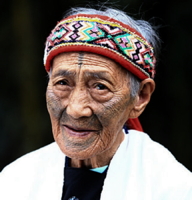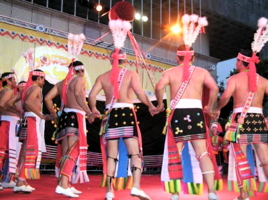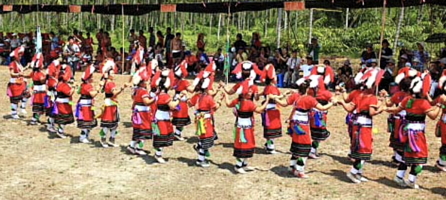
|
Folk Dance Federation of California, South, Inc.
|

|
CLICK AN IMAGE TO ENLARGE
Taiwanese aborigines are Austronesian people. Long before the Han Chinese immigrated to Taiwan, Taiwanese aborigines inhabited the island. They can be roughly categorized into two main groups: Palins Aborigines, who live in the lowlands, and Highland tribes, who live in the mountainous area. Currently, there are fourteen tribes officially recognized by the Taiwan government.
According to anthropological studies, Taiwanese aboriginal building construction, cultivation method, betel nuts-eating, tattooing, leather costume-making, round dancing, and other cultural practices show that they are one of the Austronesian peoples, both genetically and linguistically. They are closely related to other Austronesian populations in the Philippines, Malaysia, Indonesia, Madagascar, and Oceania. Originally they were widely distributed in the mountainous areas of Taiwan (especially in central Taiwan), and formed tribal units along the alluvial plains. Traditionally, they were hunter-gatherer societies. In recent years, however,the life-style of those who live nearer to the lowlands has become similar to that of the Han Chinese, even though the tribal structure is still perserved.
 Their clothing is usually made from a fiber called "ramie." It is lustrous, looks like silk, and sometimes is mistaken for linen. Adult males wear short skirts, females wear long skirts. Feathers and tail quills are the favorite materials for the ornaments of the headgear. The aborigines used to wear tattoos, and while they still do so nowadays, the patterns have become more discreet. They believe in ancestor spirits and think that these mountain spirits will protect them and bless them with abundant harvests. From January throughout December each year, every tribe holds its own specific festivals.
Their clothing is usually made from a fiber called "ramie." It is lustrous, looks like silk, and sometimes is mistaken for linen. Adult males wear short skirts, females wear long skirts. Feathers and tail quills are the favorite materials for the ornaments of the headgear. The aborigines used to wear tattoos, and while they still do so nowadays, the patterns have become more discreet. They believe in ancestor spirits and think that these mountain spirits will protect them and bless them with abundant harvests. From January throughout December each year, every tribe holds its own specific festivals.
Music is an important aspect of Taiwanese aboriginal cultural life. In earlier days, the major musical form was singing. Their songs tell us that music is very closely linked with their daily life, as they have songs for work, for young children, love, storytelling, ritual, moral lessons, festivals, etc. Singing is the main expressive form of their music.
Taiwanese aboriginal songs display the abundant cultural resources in Taiwan. Unfortunately, what we can find in literature is largely constrained by the musical training of early collectors. Therefore, what has been recorded are mostly lyrics without melodies; the latter are only preserved in the oral history. With the passage of time, many songs have been in danger of being lost forever. In recent years, the government has been promoting the concept of localization, and a Taiwanese society started to recognize the importance of the study and preservation of cultural resources. Now, more and more researchers devote themselves to related studies.
Because the Taiwanese aboriginal cultures have great diversity, musical culture can be very different across different tribes, locations, and environmental conditions. There are plenty of opportunities for further research and preservation. On the other hand, aboriginal people in their hometowns try to preserve and promote their languages and traditions. They combine it with tourism and even with popular music, all of which helps them to achieve economic independence.
The Ami
Ami are found in eastern Taiwan, including the Taitung Longitudinal Valley and the Coastal Plain, with a population of around 157,000, making the Ami the largest among the Taiwanese aboriginal tribes. In the 17th and 18th centuries, the Ami were threatened by the Atayal and Bunun from the adjacent west and the Puyuma from the south. They were also affected by other Plains Aborigines who were forced to migrate by the Han Chinese in the western plains of Taiwan. Therefore, the Ami people have variety among themselves. Nowadays, there are five major groups identified from the north to the south: Nanshih Ami, Ami Hsiukuluan, costal Ami, Puyuma Ami, and the Hengchun Ami. Most of them live in the plains near the coast or the rivers.
The Ami are a matrilineal society and the male members are organized by age. Age also decides the distribution of powers and the responsibilities among male and female members in a tribe. Because of the age-class structure, male members respect the elders, and the elders hold the responsibility for making decisions. The chief will consult the elders before making decisions for the village. Work is assigned to the members according to their age group. Younger ones usually shoulder more of the labor.
The Ami Harvest Festival
 The Ami have various festivals during the year, such as the Harvest Festival and the Fishing Festival.
The Ami have various festivals during the year, such as the Harvest Festival and the Fishing Festival.
The Harvest Festival is the most important one in which we can see a splendid display of Ami culture. It can last from one to seven days, starting in the Taichung area in mid-July and gradually moving northwards through different villages, ending in Hualien County in late August or early September. Many years ago, the Harvest Festival was held in October, but in recent years it has been held in the summer to accomodate tourism.
The Ami practice farming as well as hunting, so they have also developed a specific farming culture. In the Ami language, kilumaan means "Harvest Festival." As legend had it, a long time ago, a serious drought lasted for several years and damaged all the crops, leaving the Ami people living in great hardship. The heads of the families gathered together to discuss what to do. They came up with the idea of holding a great ceremony to ask the ancestors for rain. After the ceremony, it did rain, which saved the crops and the people.
In order to express their gratitude, the chiefs decided that they hold a gratitude ceremony, in which everyone should stop working and the women should prepare the meals and the men should go fishing (it is said to be the origin of the Fishing Festival), and everyone should sing and dance to celebrate the coming of the rainy season. AFter this ceremony was held, the next year was a plentiful year, just as expected. Since then, the Ami have always held a festival in the summer to express their gratitude to the ancestors and the spirits and to pray for an abundant harvest for next year. This is said to be the origin of the Harvest Festival.
The Harvest Festival is an important way for the Ami to celebrate their harvest. It is held after the busy farming season so it not only celebrates the harvest of the year, but also allows people to have some rest after a year's hard work. Furthermore, it helps to connect people in a tribe and and is educational for younger generations. In the festival, the Ami people dance and drink together regardless of gender and age. This shows their passionate, positive, bold, and unconstrained nature. Nowadays, the Harvest Festival not only provides the Ami people with a time to relax and celebrate but it also provides visitors an opportunity to see and join the festival.
In the festival, the Ami people form a big circle to sing and dance. There is a great repertoire of songs and dances. In the circle, some people start the song and dance. Some people start the song and others answer. In the circle, people learn to respect the harmony, as has been the custom for many generations.
The Harvest Festival had another level of meaning: it provided the opportunity for men to perform their military training. There used to be a lot of training to develop their physical strength and the sense of belonging to the group. Now this training has largely disappeared from the Festival, and what is left are sports and fishing as well as singing and dancing. Whenever a young man is going to do his military service, however, the family holds a banquet for relatives and friends the previous evening, and people sing and dance as in any other formal occasion. They still hold that a young man's military service is formal training on behalf of the country and is an important part of a man's life.
Strictly speaking, the Harvest Festival is an activity focusing on men rather than women. It includes teaching the young men about etiquette, singing, and dancing. According to tradition, the Harvest Festival starts in the night, and on the first day the women are not allowed to join. On the last day, all the women have to show up, and the festival finishes with their singing.
Although there have been quite a few changes from the past to today, the Ami still hold their festivals every year. The reason lies on the encouragement from the government and the Ami people's own value of treasuring their traditions. Those who live outside their home town traditionally return for the Harvest Festival. This self-identity suports the continuation of the festival and also makes their traditions even more meaningful.
The Ami Costume
 Most of the Taiwanese aboriginal fabrics are made from natural ramie, and then dyed with various vegetable dyes. If one took a close look, one would see that every tribe has its specific patterns. These patterns are all very pretty and would never be out of fashion. In general, Ami dress is bright and colorful. Because the Ami population covers a large geographical area, however, there are variations across different regions. In terms of color, the Ami in the north (Hualien area) use red, black, and white as the main colors. In the south (Taitung area), the characteristics of Puyuma dress have been incorporated. They wear colorful tasseled shawls, and the main colors are black, purple, yellow, green, and orange. The hat shows the wearer's social status. The more splendid the ornaments, the higher the wearer's social status.
Most of the Taiwanese aboriginal fabrics are made from natural ramie, and then dyed with various vegetable dyes. If one took a close look, one would see that every tribe has its specific patterns. These patterns are all very pretty and would never be out of fashion. In general, Ami dress is bright and colorful. Because the Ami population covers a large geographical area, however, there are variations across different regions. In terms of color, the Ami in the north (Hualien area) use red, black, and white as the main colors. In the south (Taitung area), the characteristics of Puyuma dress have been incorporated. They wear colorful tasseled shawls, and the main colors are black, purple, yellow, green, and orange. The hat shows the wearer's social status. The more splendid the ornaments, the higher the wearer's social status.
The Ami also have a great variety of bags (also known as Valentine's bag, carrying bag, and betel nut bag). Depending on the age of the wearer, they wear specific styles of bag. Generally speaking, older men wear brown linen bags while younger men wear bags with exquisite cross-stich patterns. The older men may have bags with cross-stitching, but the material is mostly chenille. The accessories include beads, feathers, bells, etc.
In different regions, the color, weaving style, beads, and pattern of Valentine's bags are varied. During important occasions or festivals, the Ami people dress formally, which is quite different according to their geographical regions, tribes, and social status. Another important accessory is the adofot, also known as taforo. Adofot looks like a sash, and is worn from the right shoulder down toward the left waist. It bears a lot of totems on the surface and is decorated with beads and bells. It is also called a Valentine's bag. On the last night of the Harvest Festival, if a woman is interested in a man, she places a betel nut in his bag. If the man also likes the woman, he eats that betel nut, and then they formally become a couple. This special convention makes adofot very romantic.
Sources
- Wikipedia.
- Taiwan Aboriginal Garment Culture Archives, National Taiwan University of Arts.
- Shung Ye Museum of Formosan Aborigines.
From the 2010 Stockton Folk Dance Camp syllabus.
Translator: Jo-Chich Yao